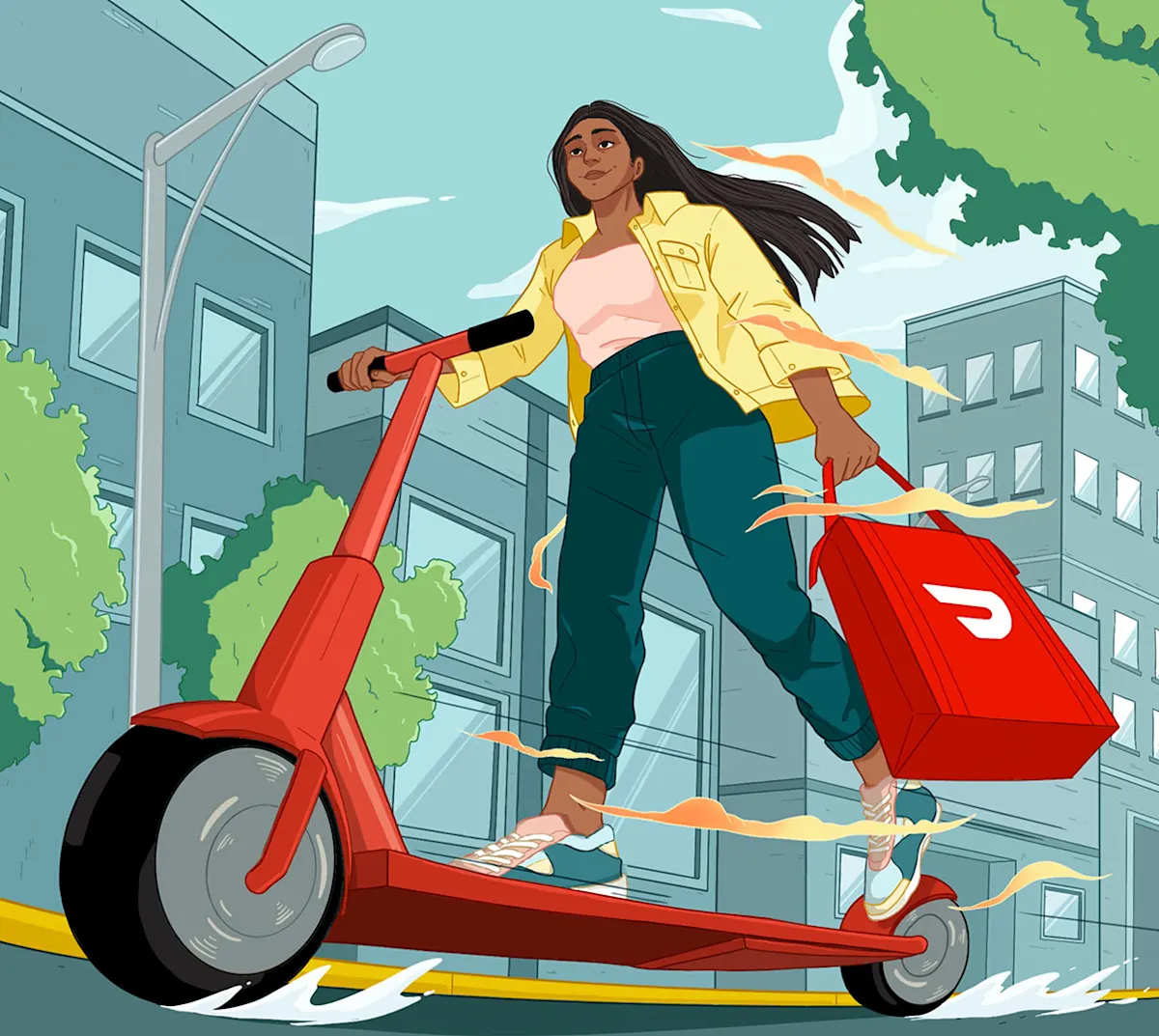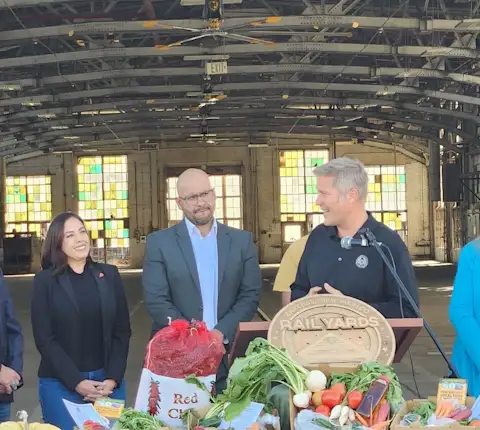We know that Dashers come to DoorDash for flexibility and the ability to earn when and where they want. In our previous policy research blog we explored how time on delivery can fluctuate among Dashers and for each individual Dasher over time. The variability we uncovered was based on their active time — the time from when a Dasher accepts an order until they complete it. We saw that over the course of a quarter, the time that Dashers spend on delivery can vary quite a bit, even for Dashers who are highly active. Dashers will often take weeks away from the platform at a time and highly active Dashers might dash 2 hours in one week and 26 hours in another.
But what about the time in between orders, or inactive time, on the app? The vast majority of Dashers average very few hours on the app per week, including their inactive time. While Dashers average just under 4 hours per week on delivery, we also saw in our previous analysis that 62% of them spend less than 4 hours per week on the app in total in 2022 Q4. In this blog, we explore how much variability there is in inactive time for Dashers and how it might be driven by their decision to accept or reject delivery offers that are presented to them. By exploring the inactive share of their time on the app, we uncover another layer of the flexibility that dashing provides.
Dashers can choose when they start and stop, which offers to accept, and to run their own errands or do something else as they evaluate which offers to take. This flexibility is critical, especially when Dashers are juggling other priorities. From our national Dasher survey conducted in March, Dashers told us that if flexible work were not available, 59% of them would spend less time caring for loved ones and 76% would cut back on household spending. This might explain why — even if they were offered some of the benefits and protections afforded to employees — 84% of Dashers would not continue to dash if they couldn't stop whenever they wanted and 80% would not continue to dash if they weren't free to turn down orders they didn't want to take. Below we see how Dashers leverage this flexibility to tailor their experience on the app.
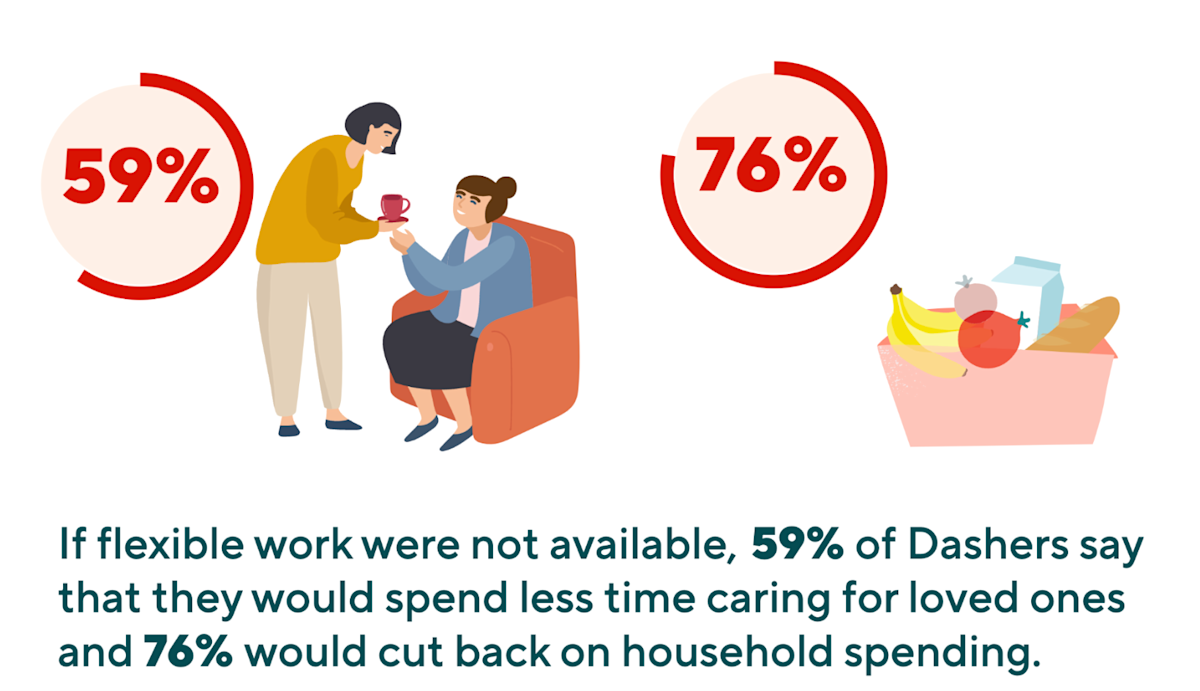
Accepting more offers means less inactive time
When we look at our data, we see that Dashers accept and decline offers as it makes sense for them. Turning to average Dashers — those who spend about 4 hours per week on delivery — we see that their inactive time can significantly vary week-to-week as they accept a greater or lesser share of the offers made to them while they’re on the app (their acceptance rate). Consequently, the acceptance rate appears to be a driver in the overall inactive time they spend on the app. The chart below shows the weekly activity for ten random Dashers who averaged four hours per week on delivery over a quarter. The red bars indicate their total time spent delivering in a given week and the pink bars above show the total inactive time they spent on the app. The top text displays how many offers each Dasher accepted in aggregate over the quarter. Most Dashers accept the offers made to them based on their needs and preferences in a given week, and their decision to accept or reject appears to influence the total inactive time they spend on the app. The 34 year old Dasher in Colorado accepting just 7% of their offers incurs much more inactive time than the 21 year old Dasher in Ohio accepting 49% of their offers:
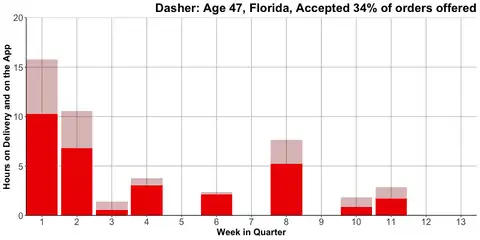
Across all Dashers, we can see the relationship between acceptance rate and inactive time on the app more clearly: as acceptance rate rises, inactive time as a share of overall time on the app falls. In the chart below we look at the distribution of Dashers by the share of time on the app they spend not doing deliveries, split out by different buckets of acceptance rates for all activity in 2023 Q2. As might be expected, Dashers who accepted 20% or less of their offers typically had a higher share of inactive time than those who accepted 50% or more of their offers. These Dashers might be on another app, running their own errands or declining offers that may not meet their preferences that day. But even a relatively small change in acceptance rate could move the needle — the median inactive time rate for Dashers who accepted between 20% and 50% of offers was 39% vs 56% for Dashers who accepted less than 20% of their offers.
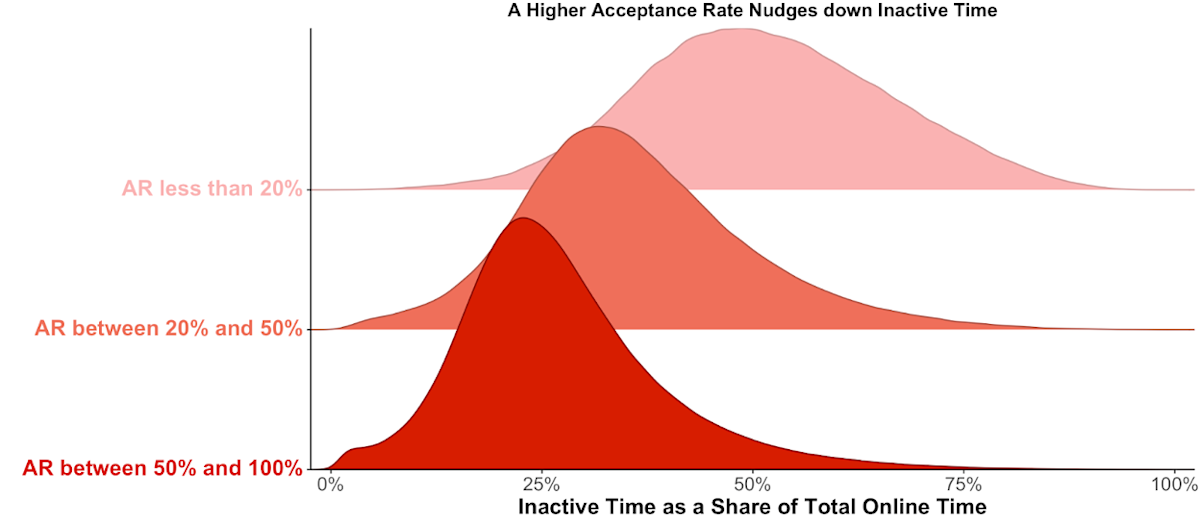
Note: This analysis is limited to instances of time on app where at least one offer was completed for Dashers who were active for at least 30 minutes on the app in the quarter.
42% of Dashers said that they do other errands and to-dos while still having the Dasher app open to review offers
But why do Dashers incur inactive time? From our national Dasher survey, we learned that 60% of Dashers combine dashing in some way with other activities like running their own errands. This could mean starting a dash after their grocery run or finishing one before their next errand. As we’ve seen, Dashers can and do weave dashing more directly into their personal activities and some of this could be during inactive time on the app.
To understand more, we recently surveyed over 1,200 Dashers on how dashing fits into their lives, what other activities they do during their inactive time and why they reject offers. One way they incorporate other activities is by keeping the app open in the background as they go about their daily routines.
42% of Dashers said that they do other errands and to-dos while still having the Dasher app open to review offers, including completing other tasks like getting groceries, picking up/dropping off their children between deliveries, commuting to a job or school or switching to another delivery or rideshare app.*
Over 50% of Dashers do leisure activities like reading books, playing games or catching up with their friends and family while having the app open and being able to review orders.
Inactive time may also result by accident: almost one in five say they sometimes or often forget to close the app, even though they’ve finished dashing and one in six Dashers say they stop performing deliveries but don't pause the dash or close the app.
In fact, 25% of Dashers active in 2023 Q2 had opened the app at least once for 30 minutes or more, received two or more offers, and logged off without accepting or completing a delivery. “It’s nice to be able to jump on and go into the store for myself and pick up a few bucks doing some dashing” says Carrie, a Dasher in New York and mom of four, “I’ll do that maybe twice a week.”

Many Dashers are doing personal activities or non-dashing work alongside their dash to some degree, and the data shows that these activities were typically more prevalent among Dashers with lower acceptance rates than Dashers with higher acceptance rates:
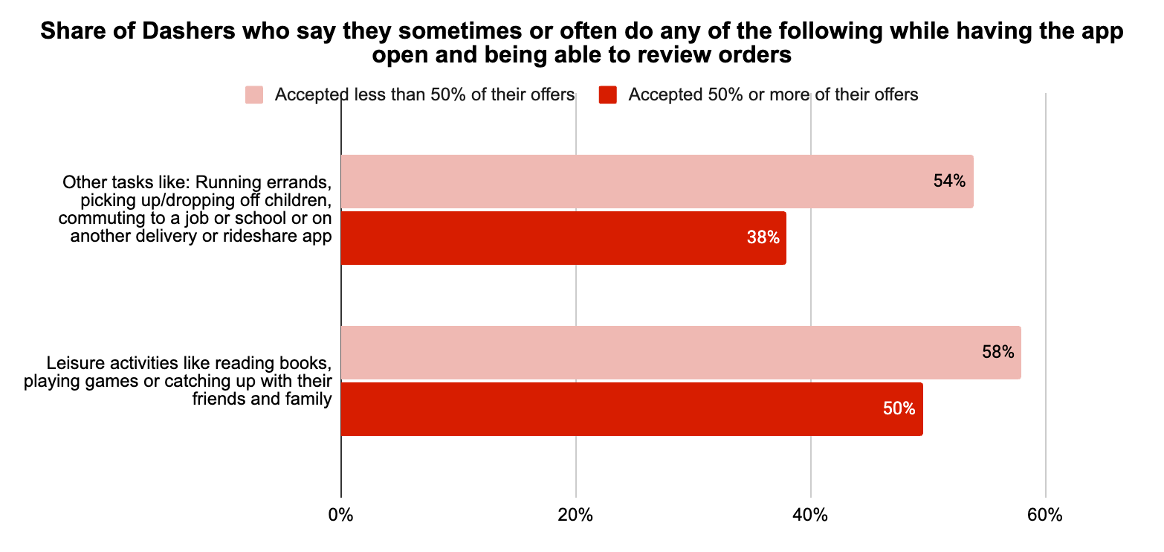
Almost a quarter of Dashers who are parents say that they sometimes or often pickup/dropoff their kids between deliveries and 27% of student Dashers commute or travel to a job or school while on the app, which is made easier with features like Dash along the Way.
“Dashing is easy for me, as I’m driving into town to run errands I can pull up the app and do little dashes here and there. Being able to make money on my own schedule makes it more convenient,” says JP, a Dasher in California studying to become a paramedic.
Dashers get offers over twice as frequently as they accept them, and they choose to reject for a variety of reasons
In aggregate, Dashers in 2023 Q2 received over twice as many offers as they accepted. This was echoed in our latest survey where 77% of Dashers say the freedom to accept or reject any offer is one of the main reasons they deliver with DoorDash. Offer frequency was also seen positively with 71% agreeing that they get offers frequently and the majority of Dashers being satisfied with how many offers they typically receive.

When considering whether to accept or reject an offer, the components of the offer are the biggest factors. 79% of Dashers say they sometimes or often reject an offer because some component of the offer is not right for them. That may be because the order would take them to an area that’s not ideal for them (e.g. too far from home, opposite direction of where I want to go) or because there wasn't enough value for the Dasher.
While DoorDash is always working to make offers more attractive to Dashers — including by improving how we batch deliveries and providing more ways to earn such as through shopping for grocery and convenience orders — we also learned of reasons besides the offer component that lead Dashers to rejections.
35% of Dashers say they reject offers when they’re busy running errands or if something important to them comes up.**
Almost a quarter of Dashers say they reject offers because they’re busy doing something else, like running errands or completing a delivery/ride with another gig company.
Sometimes, they simply aren’t in the mood — about 16% say they reject offers because they don’t feel like starting one at the moment.
These reasons were more prevalent among Dashers with low acceptance rates:

“I dash either before or after work, if I have to run out to do something or on the weekends.” says Amie, a Dasher from Texas with a full-time job. “If I have to run to the grocery store, I’ll turn on the app and head in that direction… If I have to go to the other side of town for a store, I’ll dash over there too.” And flexibility means that Amie can always reject offers on her errands: “If I’m in the middle of the store and the app goes off, I ignore it. Once I’m going through the checkout, I’ll start accepting orders again.”
Dashers accept offers based on their preferences on any given day
Because they're juggling busy lives, how Dashers choose which offers to accept on one day might be totally different from their preferences on another day. Looking at the chart below, we see the acceptance rate and inactive time over April 2023 for ten Dashers, chosen at random. To ensure we’re looking at similar dashes over this period, we limit this analysis to days in which the Dasher received at least 10 offers while on the app and at least 3 offers per hour. Only Dashers who were active in at least 15 out of 30 days of the month are included so that there’s enough data on their acceptance behavior.
The smoothed line in the chart represents their acceptance rate and the bars represent the share of inactive time they incurred while on the app. There are big swings between the acceptance rate for comparable dashes and their inactive time can vary dramatically. Dasher 1, for example, accepted 50% of their offers during one dash and 100% of their offers during another, giving them a range of 50 percentage points in their acceptance rate. The same swings exist for their inactive time: this Dasher had a high of spending 36% of their time on the app as inactive vs a low of 4%.
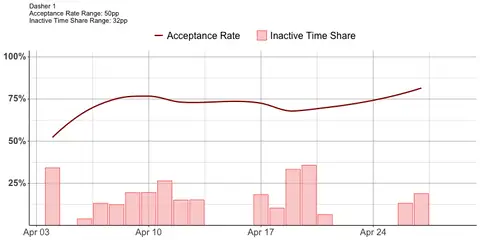
Note: The AR line is smoothed which reduces day-to-day volatility.
The flexibility of dashing means that Dashers can earn when they choose down to the minute – and stop when they want. From catching up with family and friends to picking the right order for them, Dashers leverage the DoorDash platform in many ways that fit into their lives without sacrificing the activities they love.
*Based on Dashers who said they sometimes do these activities or often do these activities while on the app.
**Based on Dashers who said they sometimes reject offers for this reason or said that this was the most common reason they rejected orders.
